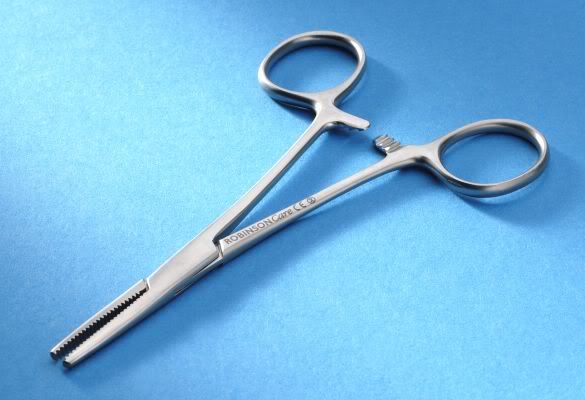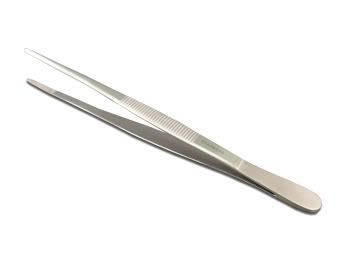I had been given the opportunity to handle rats and dissect them to collect fresh tissues for my experiment. Now i will share with you how to dissect a rat to obtain its arterial blood.
Firstly, the rat was recorded for its weight and anaesthesia was given to it accordingly. Then the rat would go lose consciousness about 5-10 minutes after intraperitoneal administration. A toothed forceps is then used to pinch the rat's feet to make sure that it has totally lost consiousness. Then, we use the back of the forceps (blunt) to poke its eye. If it still has the ability to blink, it means that the rat is still conscious and we have to wait for a while more before the surgery can begin.
When the rat has lost all consciousness, we lay the rat face-up and using a forcep, lift the skin from the neck area and cut a hole using the surgical scissors. Using a pair of arterial forceps, we then separate the neck muscles to locate the vein of the rat (which is light purple in colour). Once located, a slit is made using a vannas scissors and a cannula is inserted into the vein to infuse saline into the rat so that it does not get dehydrated. Then the cannula is tied to the vein using thread. The artery is then located (thicker than the vein and is redder) and lifted upwards. We must make sure that only the artery is lifted up and not with other nerves or connective tissues. Using the arterial forceps, we stretch the artery (artery is elastic) to stop the blood from flowing so that when we make a slit, the blood does not spurt out. Then a slit is made using the vannas scissors and a cannula which is connected to a syringe that was pre-rinsed with heparinized saline, so that the blood collected would not clot, would be inserted into the artery. Blood is then drawn from the artery into the syringe and then placed into a falcon tube and then centrifuged.

Vannas scissors
Retrieved on June 28, 2009 from website http://www.wpi-europe.com/images/microdissection/images/501778-from-14003.jpg

Arterial forceps
Retrieved on June 28, 2009 from website http://www.oncallmedicalsupplies.com/acatalog/7908large.jpg

Forceps
Retrieved on June 28, 2009 from website http://merrickmedical.com/images/forceps.jpg
Please feel free to ask questions if you do not understand any of things i have written above.
Loves,
Renee
0703634F
TG02
Tagger: Janice Yeh (Grp 6)
ReplyDeleteAdmin No.0701885F
Hey Renee!!! your week sounds really cool!!! haha. you get to deal with life specimens!
are you in a animal lab? has your project something to do with rats?
okok... the more serious questions are:
'How come you must the cannula be tied to the vein?'
is it becos it facilitates that extraction of the arterial blood?
Thanks! :D
Wah!Look at those devices, so scary ahhaha =P
ReplyDeleteAsk u something, if blood is not immediately used after the dissection, can it be stored? If yes, what's the condition and how long can it be kept under that condition? =D
Extra question [not so relevant, just curious, lolz]: what will happen to the rat after it gains consciousness? Or it already dies........T_T
Vo Thu Hong Anh [Jess]
0705364H
HULLOOO RENEEEEEEEEEEEEEE!
ReplyDeleteomg =(((((((((((((((((((((
anywaes, could u explain more about the infusion of saline? how does the rat get dehydrated? your blood is collected from the artery then what significance is there to insert saline into the vein ah? like how does it affect?
Joanna Yeo
0702054H
heyy!
ReplyDeleteI have some questions here:
1. You said that "We must make sure that only the artery is lifted up and not with other nerves or connective tissues". What happened if you accidentally lifted up the nerve or tissues? Would it affect the consciousness of the rat?
2. What type of rat you use?
Sit Shahimah
(0702717J)
Hi Renee.
ReplyDeleteSeems like you are doing some intersting experiments. You actually dissect them!
One question!
You were saying you collect fresh tissues for your experiment. But you didnt really explain on it. Could you tell me more about it? Like how do extract the tissues from the rat? Just cut a part of their organ off and extract off the tissues or wad?
Looking forward in your answer!
Jordan Wong
TG02 Group 9
Anyway Renee. Please note.
ReplyDeleteWe are GROUP 9 not GROUP 7
FYI =)
Cheers
Jordan Wong
OOPS. haha! im sorry jordan. HAHA! suddenly forgot that we are group 9.
ReplyDeleteanyway, here to answer the questions!
Too all the Miss Js. HAHA! I just realized that all of your names start with J!
Reply to Joanna
The infusion of saline is to compensate for the blood loss during surgery. It is to maintain the body fluid balance in the rat’s body.
Another reason is that the anaesthesia for the rat would also be infused through the vein when the animal is starting to regain consciousness. This is done by changing the syringe containing saline to the syringe containing anaesthesia. The cannula is this long tubing and therefore, anaesthesia given may be stuck halfway in the cannula and therefore, the saline is also to help push the anaesthesia into the rat’s vein.
Reply to Jess
Yups. In this experiment, we are actually freezing plasma. The plasma would be stored at -80oC and it can be stored for up to 12 months : )
Actually for this dissection, the rat is not supposed to wake up. When we take out blood (we usually take out 10ml of blood), the rat is almost on the verge of dying. So we give the rat phenobarbitone (euthanasia) straight into the heart so that it will die. I saw one rat that woke up halfway during the operation (due to inadequate anaesthesia given) and then all the intestines and everything just spilled out. So sad: (( Then the rat’s BP started dropping and because we needed to collect fresh blood and tissue, we hurriedly suck out the blood and collect the tissue. Due to the large loss of blood and tissue collection from the rat’s sensitive area, the rat died. (I will be explaining the process of taking the tissue in my next post! So stay tune: ))
Reply to Janice
HAHA! I’m not in an animal lab. We use rats to conduct experiments to see the effect of the drugs. The purpose of tying the cannula to the vein is to prevent the cannula from coming out of the vein. Actually, anything that is cannulated must be tied so that the cannula does not come out of the vein/artery/trachea (these are places that are usually cannulated) easily.
Reply to Siti
HAHA! the rat that I use is called the Sprague-Dawley rats, it is those common laboratory rats that are used. It is white in colour with a very long tail. The reason why we only lift the artery up and not with the other nerves and tissues is because we want to visualize the artery to cannulate it. If it is with a mixture of nerves and connective tissues, then it will be more difficult to cannulate the artery. The artery that we cannulate is called the carotid artery and lying beside it would be the vagus nerve and damage to this nerve might cause brain damage, so we must also be careful due to this reason: )
To Jordan,
Hey Mr. J, i will answer your question during the next post alright? because i am planning to write out the whole procedure of tissue collection and BP and ICP taking next week.
Stay tune!
Hope I answered all your questions: ) anything that you still don’t get from my explanation, feel free to ask me again: )))
Loves,
Renee
0703634F
TG02
This comment has been removed by the author.
ReplyDeleteHey Renee! One curious question: The needle your use to draw blood and give anaesthesia, is the size of the needle the same as the one used for humans or much smaller? Since, rat's veins are much smaller and all.
ReplyDeleteGoh Michelle
Reply to Michelle
ReplyDeleteHey mich, we draw the blood through the cannula. It does not matter whether the rat's vein is big or small, because it is already cannulated. So we just have to fit the needle into the cannula (and not into the rat's artery) and then just pull the syringe and the blood will flow from the artery into the cannula then into the syringe: )
Love,
Renee
TG02
0703634F
Hi! Renee!
ReplyDeleteIs this the only way to get a large amount of blood from rats? Cause I thought you can get the blood from under the eyes without killing the rat?
Thanks!
eriko
0700477C
Hey renee, wouldnt anesthetic affect ur blood sample experimental results, im in animals facility lab too messing with wistar outbred strains
ReplyDeleteRaymon su
TG01-unstoppable
Hello Eriko and Raymon! HAHA!
ReplyDeleteReply to Eriko
We actually collect about 12-14ml of blood from the rat, which is almost 90% of the rat's circulating blood volume. This means that the rat would eventually die no matter what method we use to collect the blood. The use of retro-orbital bleeding is actually a much slower method to collect blood compared to directly taking it from the carotid artery of the rat and the amount of blood obtained from the retro-orbital plexus is lesser too: )
Reply to Raymon
YO Raymon! you are in the animal facility lab? COOL!!! HAHA! What type of animals do they have there? HAHA! Wistar is another breed of rats? okok, now to answer your question. The anaesthesia does affect the blood sample that i am collecting. However, the anaesthesia that we give is diluted anaesthesia (1 portion of anaesthesia into 9 portions of saline (10x dilution). Thus, it does not really affect the results obtained from the blood sample. We just have to make sure that when we collect the blood, no infusion of the anaesthesia is given: ))
yupps. I've answered the questions:)
anything to clarify just ask me!
Loves,
Renee
TG02
0703634F
Yo! Renee! Thanks! I understand now:)
ReplyDeleteeriko
Thanks for the info yo!
ReplyDeleteIt's horrrible to witness such kind of scene T_T
Vo Thu Hong Anh [Jess]
0705364H